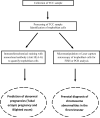Transcervical retrieval of fetal cells in the practice of modern medicine: a review of the current literature and future direction
- PMID: 20056202
- PMCID: PMC2847626
- DOI: 10.1016/j.fertnstert.2009.11.022
Transcervical retrieval of fetal cells in the practice of modern medicine: a review of the current literature and future direction
Abstract
Objective: To review published methods for transcervical collection of fetal cells and to assess the potential of this approach for application in prenatal diagnosis.
Main outcome measure(s): Retrospective analysis of efforts at prenatal diagnosis with trophoblast cells shed into the lower uterine pole that accumulate within the cervical mucus at the level of the internal os.
Result(s): Minimally invasive techniques that include cervical mucus aspiration, cervical swabbing, and cervical or intrauterine lavage can be used to retrieve trophoblast cells during the first trimester for diagnostic purposes, including for prenatal genetic analysis. Fetal cells have been identified in these specimens with success rates that vary from 40% to 90%. The disparity in reported success rates can be a function of gestational age, collection method, operator variability, detection sensitivity, or pregnancy status. Molecular approaches have been devised to determine fetal sex and identify aneuploidies. Antibody markers have proven useful to select trophoblast cells for genetic analysis and to demonstrate that the abundance of recoverable fetal cells diminishes in abnormal gestations, such as in ectopic pregnancy or blighted ovum.
Conclusion(s): Transcervical collection of fetal cells offers several avenues for prenatal diagnosis that with further refinement could one day provide valuable information for the management of ongoing pregnancies.
Keywords: Prenatal diagnosis; cervical mucus; ectopic pregnancy; fetal cells; genetic analysis; immunological markers; intrauterine lavage; transcervical cell collection; trophoblast.
Copyright 2010 American Society for Reproductive Medicine. All rights reserved.
Figures


Similar articles
-
Trophoblast retrieval and isolation from the cervix: origins of cervical trophoblasts and their potential value for risk assessment of ongoing pregnancies.Hum Reprod Update. 2018 Jul 1;24(4):484-496. doi: 10.1093/humupd/dmy008. Hum Reprod Update. 2018. PMID: 29608700 Free PMC article. Review.
-
Retrieval of trophoblast cells from the cervical canal for prediction of abnormal pregnancy: a pilot study.Hum Reprod. 2009 Sep;24(9):2086-92. doi: 10.1093/humrep/dep206. Epub 2009 Jun 4. Hum Reprod. 2009. PMID: 19497946 Free PMC article.
-
Methods for the transcervical collection of fetal cells during the first trimester of pregnancy.Prenat Diagn. 1995 Oct;15(10):933-42. doi: 10.1002/pd.1970151008. Prenat Diagn. 1995. PMID: 8587861
-
Fetal cells in transcervical samples at an early stage of gestation.J Hum Genet. 2001;46(3):99-104. doi: 10.1007/s100380170095. J Hum Genet. 2001. PMID: 11310588 Review.
-
Endocervical fetal trophoblast for prenatal genetic diagnosis.Curr Opin Obstet Gynecol. 2006 Apr;18(2):216-20. doi: 10.1097/01.gco.0000192985.22718.17. Curr Opin Obstet Gynecol. 2006. PMID: 16601483 Review.
Cited by
-
Isolation of HLA-G+ cells using MEM-G/9 antibody-conjugated magnetic nanoparticles for prenatal screening: a reliable, fast and efficient method.RSC Adv. 2021 Sep 20;11(49):30990-31001. doi: 10.1039/d1ra05988b. eCollection 2021 Sep 14. RSC Adv. 2021. PMID: 35498932 Free PMC article.
-
Common chromosomal aneuploidy testing using non-invasive trophoblast retrieval and isolation from the cervix (TRIC) in pregnant women.Arch Gynecol Obstet. 2025 Aug 21. doi: 10.1007/s00404-025-08156-7. Online ahead of print. Arch Gynecol Obstet. 2025. PMID: 40841462
-
Application of polymerase chain reaction for fetal gender determination using cervical mucous secretions in the cow.Vet Res Commun. 2012 Dec;36(4):215-20. doi: 10.1007/s11259-012-9532-z. Epub 2012 Aug 3. Vet Res Commun. 2012. PMID: 22865471
-
Fetal genome profiling at 5 weeks of gestation after noninvasive isolation of trophoblast cells from the endocervical canal.Sci Transl Med. 2016 Nov 2;8(363):363re4. doi: 10.1126/scitranslmed.aah4661. Sci Transl Med. 2016. PMID: 27807286 Free PMC article.
-
Altered Biomarkers in Trophoblast Cells Obtained Noninvasively Prior to Clinical Manifestation of Perinatal Disease.Sci Rep. 2016 Sep 23;6:32382. doi: 10.1038/srep32382. Sci Rep. 2016. PMID: 27660926 Free PMC article.
References
-
- Egan JF, Benn P, Borgida AF, Rodis JF, Campbell WA, Vintzileos AM. Efficacy of screening for fetal Down syndrome in the United States from 1974 to 1997. Obstet Gynecol. 2000;96:979–85. - PubMed
-
- O'Leary P, Breheny N, Dickinson JE, Bower C, Goldblatt J, Hewitt B, et al. First-trimester combined screening for Down syndrome and other fetal anomalies. Obstet Gynecol. 2006;107:869–76. - PubMed
-
- Mujezinovic F, Alfirevic Z. Procedure-related complications of amniocentesis and chorionic villous sampling: a systematic review. Obstet Gynecol. 2007;110:687–94. - PubMed
-
- Handyside AH, Kontogianni EH, Hardy K, Winston RM. Pregnancies from biopsied human preimplantation embryos sexed by Y-specific DNA amplification. Nature. 1990;344:768–70. - PubMed
-
- Steele CD, Wapner RJ, Smith JB, Haynes MK, Jackson LG. Prenatal diagnosis using fetal cells isolated from maternal peripheral blood: a review. Clin Obstet Gynecol. 1996;39:801–13. - PubMed
Publication types
MeSH terms
Grants and funding
LinkOut - more resources
Full Text Sources
Other Literature Sources
Medical

